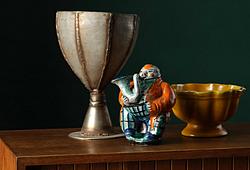MYNT, Silver. Kina daterat 17 året, 1928.
Ett s.k. Kewichow Auto Silver Dollar mynt. Mått circa 3,8 cm.
Slitage.
Proveniens
The Collection of Erik Nordström (1884-1971). Erik Nordström was commissioned after a recommendation by Swedish minister Gustav Oscar Wallenberg, the Envoyé of Japan and China, as Post General in Shanghai at the Royal Chinese General Post Office in 1910. The aim was to help facilitate its work throughout China. He was positioned in several of the Chinese provinces (he often chose the northern provinces due to their resemblance to the northern Sweden where he stems from) over his 35 years in the postal service.
Gustav Oscar Wallenberg who became a close and dear friend of Erik Nordström, was a keen collector of Chinese ceramics and introduced him to the art of collecting by defining age, quality and heritage as they visited the antique shops of Beijing. The vast collection of Eric Nordström contains a variety of objects of which many were acquired for the purpose of everyday use, hence the wear to many of the objects.
During his time in China he encountered and befriended many of the Swedish society who both worked and lived as well as passed through China at the time, i.e. Johan Gunnar Andersson and wife, Sven Hedin, Carl Bonde, Sten Thiel in the company of Nils von Dardel and his then fiancé Nita Wallenberg, to name only a few.
Erik Nordström was a keen sportsman and always liked a challenge whether it be hunting, shooting or tennis. He retired in China in 1945 and spent his last years in Qingdao before his return to Sweden in 1948.
By the time he left China in 1948 he and his family had experienced the Chinese revolution, World War I and the Japanese invasion and World War II.
Utställningar
Compare similar coin sold at Rosemont Signature World & Ancient Coin CICF Auction.
Övrig information
This Silver Dollar was struck to commemorate the first road in the Province of Kweichow and said to feature the Governors automobile on the obverse.
'By the year 1926, the most famous builder of motorized roads in China's history was one Chow Hsi-Chen, the military governor of Kweichow Province and a powerful warlord. He succeeded in building a massive highway systems that linked all areas of his province. After completing his road project, General Chow to mark the occasion, expressed a desire to strike a commemorative coin. He announced that it should bear his famous automobile, one of the very few imported into the country.'
'He also wanted the coin to bear his likeness. His advisers had no objection to the vehicle but counseled against his appearance on the commemorative. It seemed soothsayers and other Feng Shui experts predicted his life would be in jeopardy should his likeness appear. The warlord saw no reason for the omission of his effigy as other notabilities of the nation had previously appeared, but relented in the end on condition that his name at least be marked on the coin.'
'A commemorative was designed with his name in Chinese characters hidden in the blades of grass that make up the grass verge in the exergue of the coin. In other words, it was an arrangement of the blades below the automobile to inconspicuously resemble the warlord's name in Chinese characters for Hsi-Chen. [The characters can be seen when the coin is held so that the front of the automobile is pointing straight up.] His advisers were not happy with this arrangement. This commemorative coin was minted in the 17th Year of the Republic (1928) and issued for circulation thereafter.'


































